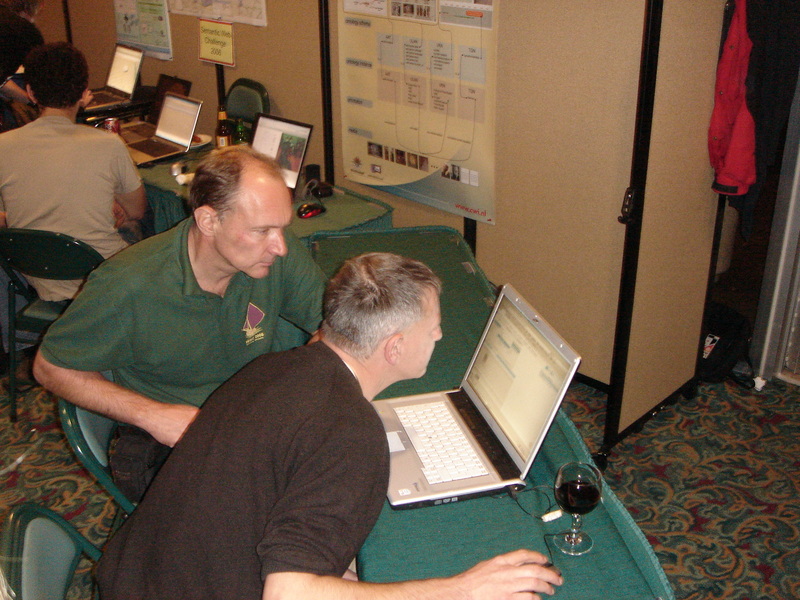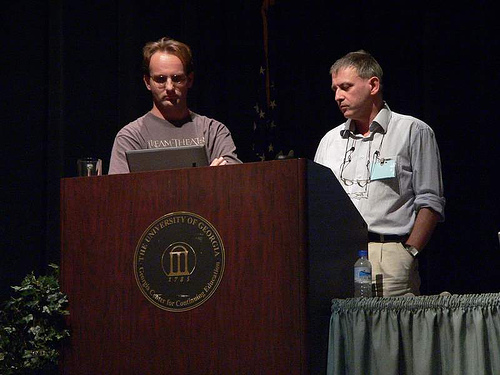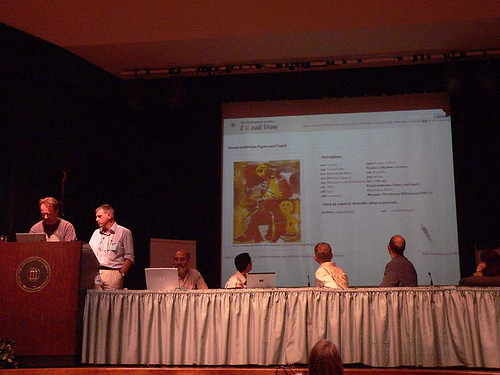ISWC2006
CWI participants: Jacco, Lloyd, Michiel, Stratos, Errietta
# participants: 500
The ontology is not the context. Instead the ontology is itself put into a context. Then the context gives a perspective/view to the ontology.
family of ontologies and c-mapping between them a mapping is a set of bridge rules. 5 bridge rules that relate concepts from two different ontologies (subset, equality, ...)
He shows examples from Frank about mapping. General idea use background ontology where you anchor the two, to be mapped, ontologies.
Grounding a concept: How it appears in a document(s). Related to symbol grounding in AI, instead of grounded in perception, grounding into documents.
Run a project to relate news itemsDocuments are embedded in different views. Concrete setting with news items (from reuters). Topic view and geographical view. Documents can be similar in one view but different in the other.
A lot of everything a little bit!
The workshop went very well, probably having attracted the most attendees of the conference workshops. It went far to build the sense that this is a community, that it has now developed further and that we should continue developing it. Tim Berners-Lee, Wendy Hall and other VIPs discussed their recently announced Web Science Research Initiative (WSRI) at the panel they sponsored at the workshop. WSRI aims to develop "Web Science" as a new science, with its own methodologies and reviewing criteria, to guide development of phenomenons such as Web 2.0 that raise new issues such as scale of use. We discussed SWUI as a subcase of Web Science, which also needs new methodologies and review criteria.
Tabulator is a general purpose RDF browser meant, apparently, as Tim (or W3C's?) flagship RDF browser. It does traditional browsing. It also does mSpace-like tables. Tabular also addresses knowing source of data. It has a focus on hiding URIs and other RDF as much as possible. This involved, for example, rdfs:label, even with subproperties. He wants form use, editor interface, and other upcoming features. The goal of Tabular is to exercise and test all issues, at least at the general level, for user interface with the Semantic Web.
Scott presents a way for using SW to faciliate developers sharing design rules. The design process remains predominately human, with this work facilitating communication. This paper became a CWI INS2 leesklub topic for Friday, November 10, 2006. He uses the Semantic Web to define a kind of Dublin Core for design rules. Some hearing this talk speculated afterward on going further: representing and processing details of design rules as part of rendering presentations for users. It is unclear how much of, or if, this is possible.
This paper discusses explaining why certain conclusions are made. This topic relates to our CHI paper about Henriette's study on CHIP's why button. Deborah discusses how to show the steps in making certain conclusions that the interface shows, and how to get to its source, meaning the original facts and the inferences made about them. (Inference web)
The panel, titled "Interaction Design Grand Challenges and the Semantic Web", was a very fortunately contribution. It was primarily the recently formed WSRI (Web Science Research Initiative), including Tim Berners-Lee and Wendy Hall, using the opportunity as a forum for the new group and its mission to develop a new science for Web Science. It attracted many "crashers" from other workshops, including one workshop that had all its attendees come over.
Tim Berners-Lee showed the latest version of this "layer cake" diagram, which now features an interaction layer at the very top. This combined with this development of Tabulator shows his commitment to push interaction with semantics as an important current research topic.
WSRI sponsored a dinner for the workshop. During it, Wendy and Tim were quite honest about not having developed yet a specific plan or method for the new group. They will not give research money but will seek to receive it -- that much is clear.
They will perform research with this money, one way or another. It could be that they get money to perform particular projects for which they have PhD students funded to carry out. They do want to have funding with few strings attached so they have freedom to develop there own ideas. Doesn't everybody ... but they may have the names to pull it off.
They do have a vision for a general result, however: to develop Web Science as a full-fledged science, with its own methodologies and review criteria. The topic area for WSRI is basically Web 2.0. One focus is on the concepts and models needed to support and develop the required underlying technology. Another focus is on its use, particular as an interactive experience for the individual user and as new paradigms for social interaction at a group level.
Tim was inappropriately quoted by the BBC and Guardian regarding his WSRI announcement. He meant to motivate WSRI development by saying that it would provide needed direction to Web development, and mentioned bad things that could happen without this direction. The media quoted him as saying the Web was currently heading for disaster.
The final session of SWUI06 was breakout discussions. Flipcharts, and eventually documents, for the breakout sessions are available at the workshop website. The topics were
One use case that came up in the "agenda" breakout was "user awareness of the result of pressing the camera button". Pressing the button on a camera could in the very near future result in:
SWUI activity in 2007 will not be as a conference workshop but as a working group developing instructions for pursuing and publishing SWUI research. WSRI has offered what few resources it has so far, such as affiliation resources, including Access Grid and a Southampton-based Wiki. We have discussed making this activity as case study for WSRI, with SWUI being a "sub-science" of Web Science, with the same issues for development. The current proposal is that mailing list activity, wiki development and perhaps telephone conferences culminate in a meeting at the E-Science center in Edinburgh, with a video link to MIT, along with other individual video, audio and chat feeds. The resulting document will serve those researching, writing and reviewing work in SWUI, whether it is for an upcoming SWUI workshop or for a conference for which SWUI is a component such as, hypothetically and hopefully, ISWC2007.
This is perhaps the ISWC2006 paper most closely related to CHIP because it gets users interest levels in concepts within ontologies to recommend other concepts from the domain of music. However, their work had important differences from CHIP. They lack user control: they extract user interests from blog entry text, though they vaguely describe a means of direct user control over processed interest that includes at least some form of selective removal. They also focus more on ontology merging: having user interests in one ontology give recommendations in another. Finally, they indicate little about what the user does or how this changes because of what this research offers.
Luckily, session chair Avi Bernstein started the session by announcing that this session should have been called just the "Display RDF" session. Couldn't agree more. Michiel was the first presenter, and I thought the talk went very well. People where impressed by the slides, as they clearly explained the issues and the cool embedded "live" application fragments (thanks Lloyd for the tip!) worked very well compared to the canned screen shots and prerecorded video of the other speakers. Michiel announced that he had planned a user study, but still many questions from the audience were about the fact that he didn't do this already.
Because of beamer/laptop problems, the Fresnel talk was moved to the end of the session, and Eyal Oren presented the DERI facet browser instead. There was some overlap with Michiel, but not too much, as Eyal focuses more on explaining the formal interpretation of the facet operators and the ranking metrics. A weak aspect of his talk was the lack of real world data, it make the whole talk much more academic than Michiel, who clearly had a real problem to solve. Nice aspects from this system we can add to /facet are the selections on inverse relations and existential selections.
Finally, Emmanuel Pietriga presented Fresnel using Michiel's laptop. It was well received, Tim Berners-Lee clearly wanted to have Fresnel support in his "tabulator". Emmanuel showed the use of a simple Fresnel lens to select and order 4 properties of a city to show in the interface. He then showed how this lense was used to display info about cities in the Longwell facet browser, his RDF graph visualizer and a geonames based map application. I liked it, but I was not sure everyone in the audience understood it was the same lens that was used to display RDF in such diverse applications (which was the whole point).
For me, this was the best session of the conference so far.Local favorite Michiel gave a talk that several (including me) called "the best talk I've seen here". Nonetheless, he was pestered for not having done a user study.
This is very interesting technology, kind of a XSLT style sheet for RDF. Wouldn't it be cool if this could encode design rules? A very big if. Unfortunately, Fresnel remains inaccessible even for geeks. Its main tool Longwell only installs for the truly skilled and developed, and its syntax is hard to author. A questioner critized the user of RDF to encode presentation rendering because this is not "knowledge". The response is that it is useful and easier to infer "assertions" about the desired presentation selection and structure from the underlying assertions to present.
CHIP and the other demos received a lot of visitors. Petko Valtchev discussed collaboration with his work on recommendation from navigation patterns, which we and Lora have begun pursuing further. Some visitors were confused with how the broadening views have some directly related links and some two degrees away. For example, it is not clear what the relationship is between the artwork being displayed and and the related artworks in the right column. Others wanted more explanation about how to rate with stars and that the dialog is the primary tasks. One visitor suggested having the starts change color from red to green, going from position to negative, which echoes suggestions from Mark van Assem's thesis. An artist discussed wanting to annotate artworks being put on the web with the vocabularies we use.

Can we integrate the resources used in different (desktop) applications into a single semantic structure? They made a collection of tools to cover the process from crawling the data, adding/deleting it from a triple store, adding annotations (creating your personal ontology) and searching and visualizing it with plugins in your existing applications.
The crawlers are modules in the aperture framework. I believe the framework is developed together with Aduna. Aduna uses it in autofocus. The crawlers can extract tags from local applications and from the web, flickr etc. If George is not aware of this he should definitely look into it.
During lunch I discussed with Leo the use of ontologies in their annotations. You can load existing ontologies and use the concepts for annotation, but it is far from trivial in their system. There focus is on creating your own "ontology". I got my doubts about this approach.
They are interested in using /facet as an interface. I will experiment with autofocus to crawl the data on my own computer, since this is more or less the same procedure as there crawling tools, but more stable.
He will visit aduna somewhere in the beginning of next year and would like to chat with our group as well. I guess we can arrange a Leesklub for that.
Knowledge Representation
Databases
NLP
Machine Learning
E-Culture won! The announcer, Peter Mika, generalized the entries by saying they "looked better", attributing it to new technologies such as Ajax.


